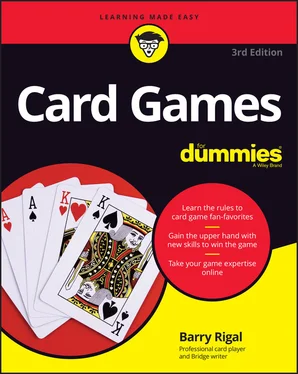Exposing yourself to public ridicule
The rules about exposed cards (accidentally dropping a card on the table as opposed to playing it) tend to vary, depending on whether you’re playing a partnership game or playing on your own:
In an individual game, the rules tend to be fairly lax; you can normally pick up your exposed cards, and the game continues. (Of course, your opponent benefits from seeing part of your hand, which is considered punishment enough for the error.)
In a partnership game, the consequences of exposing a card are much more severe because you simultaneously give unauthorized information to both your partner and your opponents. Often, the rules of a game require you to play the exposed cards at the first opportunity, or your partner may be forbidden from playing the suit you let slip. These are the Draconian rules in place with games such as Bridge, for example.
MISS MANNER’S GUIDE TO CARD-GAME ETIQUETTE
Some elements of card-game etiquette relate to basic good manners and polite behavior, and some deal with areas that come perilously close to cheating. On the etiquette front, for example, you shouldn’t pick up your cards until the deal is finished — if for no other reason than you may cause the dealer to expose a card if your fingers get in the way.
After you pick up your hand, avoid indicating in any way whether you’re pleased or unhappy with its contents. This is particularly important in a partnership game where you can’t divulge such potentially useful information.
The idea that you should play card games in silence may give the impression that you can’t enjoy yourself — that you should focus on winning to the exclusion of having fun. That isn’t the case, but you should avoid conversation if it gives away information that you’re not entitled to pass on or if the sole purpose of your remarks is to upset or irritate your partner or opponents. (The rules in Poker are a little different. Conversation during a poker game is one way for players to influence their opponents.)
The tempo of the way you play your cards can also be very revealing. You can make it clear by the way you play your card that you have doubt or no doubt at all as to what to do. You can’t eliminate doubt altogether, but you can try to make your mind up before playing a card so that you avoid conveying information by your tempo to your partner and opponents. Again, though, in Poker, anything goes!
Selecting the Best Card Game
All the card games in this book are excellent, of course — I provide only the cream of the crop. However, depending on the number of players and your collective experience and expectations, some games are more suitable than others. Depending on your needs, the following lists recommend certain games for various situations.
As a general point, though, the best card game to play is probably the one that some of your players already know. You pick up strategies of the game, as well as its customs and traditions, much faster by playing with experienced players rather than in a group consisting entirely of beginners.
If you have a specific number of players:
Solitaire games: Accordion and Poker Patience if you’re short on space; La Belle Lucie if you can spread yourself out. (See Chapter 2for Solitaire games.)
Two-player games: Gin Rummy ( Chapter 4), Spite and Malice ( Chapter 2), and Cribbage ( Chapter 16).
Three-player games: Pinochle ( Chapter 14) and Ninety-Nine ( Chapter 9).
Four-player games: Bridge ( Chapter 12), Euchre ( Chapter 10), Hearts ( Chapter 13), and Spades ( Chapter 11).
Five- to eight-player games: Hearts ( Chapter 13) and Oh Hell! ( Chapter 9).
Eight or greater player games: Eights ( Chapter 6) and President ( Chapter 17).
If you’re picking the game based on time constraints:
You can play Setback ( Chapter 15), Whist ( Chapter 8), and Euchre ( Chapter 10) to specified target scores, which you can adapt to reflect the time you have available.
You can play Ninety-Nine ( Chapter 9) for a specified number of hands.
If you have a few years at your disposal, I recommend an ongoing battle of Spite and Malice ( Chapter 2).
If you’re selecting your game based on the type of play:
Serious, competitive types tend to enjoy Whist ( Chapter 8) and Bridge ( Chapter 12).
If you’re playing in a cramped space (on a plane, train, or bus), Hearts ( Chapter 13) and Eights ( Chapter 6) work well.
In a bar, Cribbage ( Chapter 16) goes well with alcohol.
For large groups in a social setting, Poker ( Part 6) and Blackjack ( Chapter 18) are ideal.
For games that combine bidding and play, Pinochle ( Chapter 14) and Spades ( Chapter 11) are good choices.
The best partnership games are Bridge ( Chapter 12), Whist ( Chapter 8), and Euchre ( Chapter 10).
If your deck of cards is defective, you want to play a game that doesn’t deal out all the cards. You can play Oh Hell! ( Chapter 9), Spite and Malice ( Chapter 2), and Setback ( Chapter 15) with a deck that has missing cards.
If you’re selecting the game based on the experience level of the players:
For beginners: Oh Hell! and Ninety-Nine (both in Chapter 9) have simple, easy-to-understand principles.
For children: Go Fish and Cheat (both in Chapter 3) are simple, but they require younger players to think in order to win. Whist ( Chapter 8) is the best introduction to trick-taking games for children.
For groups with mixed experience levels: Whist ( Chapter 8) and Fan Tan ( Chapter 7) rely heavily on luck, which gives everyone a sporting chance. Rummy ( Chapter 4) also comes easily to inexperienced card players.
For experienced card players: Pinochle ( Chapter 14) and Cribbage ( Chapter 16) offer new thrills and challenges.
Chapter 2
IN THIS CHAPTER
 Discovering Solitaire basics
Discovering Solitaire basics
 Exploring some common versions of Solitaire
Exploring some common versions of Solitaire
 Teaming up for solitary competition
Teaming up for solitary competition
You see many different versions of Solitaire in this chapter. The different games don’t have all that much in common, except that you can play them with a single deck of cards (and they happen to be my favorite Solitaires). Some Solitaires need more than one deck, but not the ones included in this chapter (apart from the two-player, Solitaire-like game Spite and Malice at the end of the chapter). These games range from automatic Solitaires, where you can make every move immediately without thought or forethought, to Solitaires where you can plan your game strategy for at least 10 minutes if you want to. These games aren’t easy, so if you win any of them, you’ll feel a sense of achievement. In fact, I have never managed to win some of the Solitaires that I discuss in this chapter.
 To play Solitaire, you need the following:
To play Solitaire, you need the following:
One player
One standard 52-card deck of cards (you usually don’t need jokers in games of Solitaire)
Space to spread out the cards
Acquainting Yourself with Solitaire Terms
Before you start enjoying the various games of Solitaire, you need to know a little technical vocabulary:
Читать дальше

 Discovering Solitaire basics
Discovering Solitaire basics To play Solitaire, you need the following:
To play Solitaire, you need the following:










